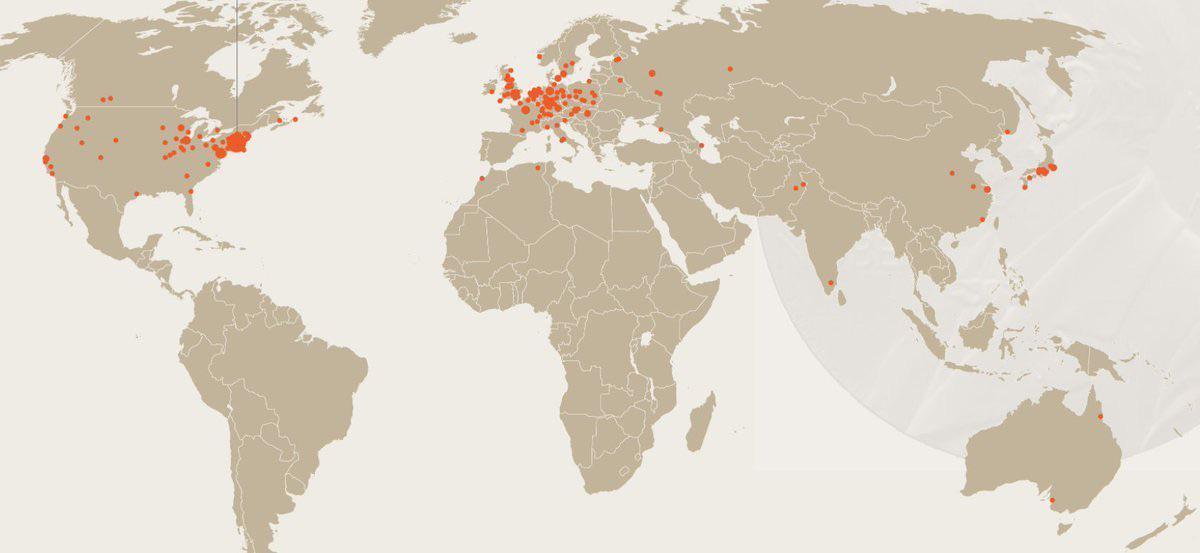Map of Birthplaces of Nobel Physics Winners


Alex Cartwright
Senior Cartographer & GIS Specialist
Alex Cartwright is a renowned cartographer and geographic information systems specialist with over 15 years of experience in spatial analysis and data...
Geographic Analysis
What This Map Shows\nThis map provides a visual representation of the birthplaces of Nobel Prize winners in Physics, showcasing a global perspective on where these esteemed scientists originated. It highlights the geographic distribution of outstanding contributions to the field of physics over the years, giving us insights into the regions that have nurtured some of the most brilliant minds in science.
Deep Dive into Nobel Physics Winners\nThe Nobel Prize in Physics has been awarded since 1901, recognizing significant achievements in the field. Since its inception, over 200 laureates have been honored for their groundbreaking work, ranging from quantum mechanics to astrophysics. What's fascinating is that these winners hail from various countries and cultures, reflecting a broad spectrum of scientific thought and innovation.
The field of physics has evolved dramatically over the decades, and so have the backgrounds of its winners. Initially, many laureates came from European countries, particularly Germany, France, and the United Kingdom. However, as the world of science became more interconnected, countries like the United States, Japan, and even nations in the developing world began to emerge as strong contributors to physics research.
For instance, did you know that the United States has produced the highest number of Nobel winners in Physics? With over 100 laureates, many of whom have made transformative discoveries, the US has become a hub for scientific research and education. This can be attributed to its robust funding for research institutions and universities, as well as a culture that fosters innovation and creativity.
Interestingly, many of the Nobel laureates in Physics were born in regions that, at the time of their birth, were either small territories or under different political arrangements. For example, Albert Einstein was born in the Kingdom of Württemberg in Germany, which later became part of modern-day Germany. Similarly, many physicists from Eastern Europe, such as Maria Curie from Warsaw, Poland, have made significant contributions to the field despite their countries facing political and economic challenges.
Furthermore, a notable trend is the increasing diversity among Nobel laureates. In recent years, winners from countries like South Africa, India, and China have garnered recognition for their contributions, reflecting a shift towards a more global representation in science. This evolution not only highlights the expanding frontiers of physics but also emphasizes the importance of collaboration across borders in tackling complex scientific challenges.
Regional Analysis\nWhen we break down the map by specific regions, interesting patterns emerge. In Europe, countries like Germany, the UK, and France dominate the list of birthplaces. Germany alone has produced numerous winners, particularly during the early 20th century when it was a leading center of scientific thought.
In contrast, North America, primarily the United States, has seen a steady increase in winners since the mid-20th century. This can be linked to the establishment of prestigious institutions like MIT and Caltech, which have attracted global talent and fostered groundbreaking research.
Asia is also witnessing a rise in its contribution to the Nobel Physics tally. Japan, for instance, has made significant strides since the late 20th century, with laureates like Yoshinori Ohsumi reflecting the country's commitment to scientific advancement. Similarly, China is rapidly emerging as a powerhouse in physics research, bolstered by substantial government investment in science and technology.
What's more, the map reveals that many Nobel laureates were born in urban areas, which often provide better access to education and research facilities. However, there are notable exceptions, like Richard Feynman, who was born in New York City, and yet brought a unique perspective that often highlighted the importance of practical experimentation in physics.
Significance and Impact\nUnderstanding the geographic distribution of Nobel Physics winners is more than a mere academic exercise; it provides insight into how scientific knowledge spreads and evolves. It raises questions about the accessibility of education and the resources available in different regions of the world. As we face global challenges like climate change and technological advancements, the need for diverse perspectives in science becomes even more critical.
Moreover, this visualization can serve as a tool for policymakers and educational institutions. By identifying regions with a rich history of scientific achievement, they can target investments in education and research to nurture the next generation of physicists. The map not only tells us where these laureates came from but also points to areas that could benefit from enhanced focus on STEM education and research funding.
In conclusion, the map of birthplaces of Nobel Physics winners not only captures a moment in scientific history but also serves as a beacon for future generations. By understanding the roots of these great minds, we can better appreciate the collaborative spirit of science and work towards a world where innovation knows no boundaries.
Visualization Details
- Published
- October 8, 2025
- Views
- 40
Comments
Loading comments...